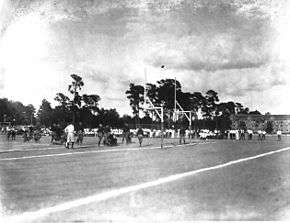Fleming Field (Gainesville)
 Football game at Fleming Field, 1924. Note Thomas Hall, background right. | |
| Owner | University of Florida |
|---|---|
| Operator | University Athletic Association |
| Opened | 1911 |
| Closed | 1930 |
Fleming Field (originally known as University Athletic Field) was the first on-campus playing surface for the Florida Gators football team and other outdoor sports programs at the University of Florida in Gainesville. It was constructed on what was then the northwest corner of the campus in the summer of 1911, and the school's football and baseball teams began using the field during the following academic year.
University Athletic Field had few bleachers and no amenities when it first opened. Larger bleachers were added around the time that it was renamed Fleming Field in honor of a former governor of Florida, but the maximum capacity was only about 5000. As the Florida football program grew in prominence during the 1920s, university leaders saw a need for a larger facility, and Florida Field was constructed adjacent to Fleming Field in 1930.
Fleming Field was used for general student recreation for many years. Today, the former site just to the north of Ben Hill Griffin Stadium at Florida Field is a landscaped approach to the modern stadium.
Earlier facilities
The University of Florida was established in Gainesville in 1906 and did not have its own athletic facilities during its first four years of existence. The first home field for its outdoor athletic teams was a municipal park in downtown Gainesville known simply as "The Baseball Park" or "The Ballpark". [1]
Home of the Gators
In the summer of 1911, the university cleared and leveled a field in a stand of pine trees just west of what is now the Murphree Area along University Avenue, just north of the present stadium site. The following fall, the school built a set of low bleachers, and its athletic teams began competing at University Athletic Field. The 1911 Florida team was the first to adopt the nickname "Gators", making University Athletic Field the first true "home of the Gators".[2] Larger bleachers were installed by 1915, when the facility was rechristened "Fleming Field" in honor of former Florida governor Francis P. Fleming.[3]
From 1911 to 1930, Florida's football squads posted a 49–7–1 record at University Athletic / Fleming Field. But because of the facility's limited capacity (approximately 5,000 with temporary bleachers and standing room) and the relative inaccessibility of Gainesville in the early 20th Century, most "home" games against top opponents were scheduled at larger venues in Jacksonville or Tampa, with a few also played in St. Petersburg or Miami.[4][5] Besides the university's sports teams, Fleming Field hosted several Major League Baseball spring training games and practices featuring the Boston Red Sox, New York Giants, Philadelphia Athletics, and Boston Braves, among others.[3]
Gator football first earned national prominence in the 1920s, prompting incoming university president John J. Tigert to begin a drive to construct a new and larger stadium upon his arrival in 1928.[6] 22,000-seat Florida Field was completed adjacent to Fleming Field in the fall of 1930, and has been the home stadium for Florida football ever since.
Later uses
Fleming Field was used as a student recreation area for almost 60 years. Tennis and outdoor racquetball courts were built on the east end, which still left plenty of open field for other uses. However, a major expansion of the north end zone of Florida Field in 1991 extended the stadium structure onto Fleming Field. The courts were removed, and the much of the remaining grassy area was landscaped with trees and sidewalks.
The former location of Fleming Field is now the main approach to what is now known as Ben Hill Griffin Stadium at Steve Spurrier - Florida Field. On football game days, the grassy areas of Fleming Field are used for parking, and a brick-paved sidewalk running across the approximate center of the Gators' first home field is the location of the Gator Walk, in which fans greet the football players and coaches as they walk from team buses on University Avenue to the stadium.
References
- ↑ Carlson, Norm (2007). University of Florida football Vault : The History of the Florida Gators. Atlanta, GA: Whitman Pub. ISBN 0794822983. p. 7
- ↑ Pat Dooley. "33. How the Gators Got Their Name". 100 Things Florida Fans Should Know & Do Before They Die: 33.
- 1 2 Carlson, Norm (14 Sep 2009). "Gator talk: History lesson". Gatorzone.com. Retrieved 19 July 2013.
- ↑ Rex Saffer, "Crabtree Leads Gators to Victory Over Oregon", St. Petersburg Times, p. 1 (December 8, 1929). Retrieved April 9, 2010.
- ↑ Norm Carlson, University of Florida Football Vault: The History of the Florida Gators, Whitman Publishing, LLC, Atlanta, Georgia, p. 38 (2007).
- ↑ Julian M. Pleasants, Gator Tales: An Oral History of the University of Florida, University of Florida, Gainesville, Florida, pp. 31–32 (2006).